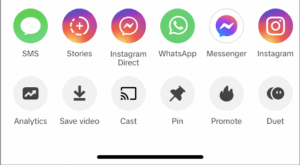
Pinterest has evolved from a simple visual bookmarking tool into a powerful marketing platform for businesses looking to increase their visibility. One often overlooked yet incredibly powerful tool in your Pinterest marketing arsenal is the strategic use of hashtags.
In this in-depth guide, we’ll share our research findings and provide you with actionable strategies to leverage Pinterest hashtags effectively for your business. Whether you’re just getting started with Pinterest marketing or looking to optimize your existing strategy, understanding the science behind Pinterest hashtags will give you a competitive edge in connecting with your target audience.
The Unique Nature of Pinterest Hashtags
Pinterest hashtags function differently from those on platforms like Instagram or Twitter. While hashtags on other social networks often serve as conversation starters or community builders, Pinterest hashtags work primarily as search terms that directly impact your content’s discoverability.
When users search for content on Pinterest, the platform’s algorithm considers hashtags as ranking factors, especially for recently published Pins.
Optimal Hashtag Strategy

The Ideal Number of Hashtags
Through our research at Tailwind, we’ve determined that the optimal number of hashtags for Pinterest Pins is between two and eight per Pin. Pins with fewer than two hashtags often miss valuable discovery opportunities, while using more than eight hashtags showed diminishing returns.
This is based on the result of our Pins study, where we found out that 19% of the most viral Pins had more than one hashtag.
Strategic Hashtag Placement
Where you place your hashtags matters. To comply with best practices, we suggest placing hashtags at the end of your Pin description rather than integrating them throughout your text. This approach keeps your description clean and readable for users while still capturing the SEO benefits of hashtags.
Relevance Over Volume
Another best practice is to focus on relevance rather than quality. It gives the algo a more direct guidance.
The Three-Tier Hashtag Formula for Maximum Reach
Here is our suggestion: We recommend a three-tier approach to hashtag selection that should make the planning and publishing process easier and quicker.
This formula helps ensure your Pins reach both broad audiences and those specifically searching for your niche offering.
Tier 1: Broad Hashtags (1-2 per Pin)
Broad hashtags represent general categories relevant to your content. They typically have higher search volumes and cast a wide net to help your Pin reach a larger audience. Examples include general terms related to your topic.
Tier 2: Specific Hashtags (2-3 per Pin)
Specific hashtags narrow your focus to particular topics, products, or styles within your broader category. These hashtags help connect you with users who have more defined interests related to your content.
Tier 3: Niche Hashtags (1-3 per Pin)
Niche hashtags are highly targeted and often represent specialized interests, specific products, or unique techniques. While these hashtags have lower search volumes, they connect your content with dedicated communities and passionate enthusiasts.
Putting the Formula Into Practice
Let’s see how this three-tier formula might work for a business posting about homemade soap:
- Broad: #handmadesoap #soapmaking
- Specific: #lavendersoap #organicsoap
- Niche: #artisansoap #smallbatchsoap
This balanced approach ensures your content reaches multiple audience segments while remaining highly relevant to your specific offering.
Measuring and Optimizing Your Hashtag Performance
Key Metrics to Track
Our research has identified several key metrics that correlate with hashtag effectiveness:
- Pinterest analytics for top-performing Pins
- Different hashtag combinations tested over time
- Competitor hashtag usage observations
- Seasonal trends in hashtag performance
Tailwind’s analytics platform is specifically designed to help you track these metrics and identify patterns in which hashtag combinations drive the best results for your specific content.
Testing and Refinement Strategies
Our most successful users follow a systematic approach to hashtag optimization:
- Testing different hashtag combinations
- Checking Pinterest analytics for top-performing Pins
- Noting which hashtags successful competitors use
- Tracking seasonal trends in hashtag performance
Common Hashtag Mistakes and Research-Backed Solutions

Our research has identified several common hashtag practices that consistently underperform:
Mistake #1: Using Irrelevant Trending Hashtags
Using popular but irrelevant hashtags just because they’re trending reduces engagement by attracting the wrong audience.
Solution: Focus on relevance over popularity. If a trending hashtag doesn’t genuinely relate to your content, skip it in favor of more accurate descriptors.
Mistake #2: Hashtag Stuffing
Using too many hashtags in your descriptions can make your content appear less professional and might be seen as spammy.
Solution: Limit yourself to 2-8 high-quality, relevant hashtags per Pin rather than using excessive hashtags.
Mistake #3: Using Spaces or Special Characters
Technical errors like using spaces or special characters in hashtags renders them ineffective as search terms.
Solution: Use only letters, numbers, and underscores in your hashtags, with no spaces or special characters.
Mistake #4: Overreliance on Very Broad Terms
Pins using only very broad, generic hashtags face too much competition and often get lost in the shuffle.
Solution: Apply the three-tier hashtag formula to ensure balance between reach and relevance.
Mistake #5: Using Identical Hashtag Sets
Using the exact same hashtag set across different content types reduces effectiveness over time.
Solution: Create custom hashtag sets for different content categories in your business, ensuring variety while maintaining relevance.
Implementing Your Pinterest Hashtag Strategy: A Step-by-Step Approach
Based on our research findings, here’s a systematic approach to implementing an effective Pinterest hashtag strategy:
Step 1: Research Relevant Hashtags
Use Pinterest’s search bar to identify popular related terms—as you type, Pinterest will suggest trending search terms that can make excellent hashtags.

Create a spreadsheet organizing potential hashtags into the three categories:
- Broad/Category hashtags
- Specific/Mid-range hashtags
- Niche/Targeted hashtags
Step 2: Develop Category-Specific Hashtag Sets
Create different hashtag combinations for each content category in your business. Each set should follow the three-tier formula while being tailored to that specific content type.
Step 3: Implement and Track Performance
As you publish new Pins, apply your researched hashtag sets and monitor their performance. Using Tailwind’s analytics tools, track which combinations are most effective.
Step 4: Refine Based on Data
After collecting performance data, analyze the results to identify:
- Your top-performing hashtag combinations
- Underperforming hashtags to replace
- New trending hashtags to test
Use this analysis to refine your hashtag library and create updated combinations based on proven performance.
Step 5: Create a Regular Review Schedule
Set a calendar reminder to review and update your hashtag strategy regularly. This ensures you stay current with changing search trends and seasonal opportunities while continuously optimizing based on performance data.
Best Practices for Pinterest Hashtag Success
Based on our research, here are the key best practices for maximizing your Pinterest hashtag strategy:
- Use 2-8 hashtags per Pin – This is the optimal range for effectiveness
- Place hashtags at the end of your Pin description – This keeps your description readable while maintaining SEO benefits
- Mix broad and specific hashtags – Using all three tiers (broad, specific, and niche) provides the best balance
- Keep hashtags relevant to Pin content – Always prioritize relevance over popularity
- Avoid spammy or repetitive hashtags – Vary your hashtags across different content types
Tools to Help With Your Hashtag Strategy
Our research found that successful Pinterest marketers often use strategic tools to optimize their hashtag approach:
Tailwind’s Pinterest analytics can help you identify which Pins (and their associated hashtags) are driving the most engagement, helping you refine your hashtag strategy over time.
Creating a spreadsheet of effective hashtags for different content categories in your business makes it easy to quickly select relevant hashtags when creating new Pins.
Conclusion: Leveraging Pinterest Hashtags for Business Growth
Our research at Tailwind clearly demonstrates that Pinterest hashtags, when used strategically, can significantly increase your content’s visibility and help you reach your target audience more effectively. The platform’s unique approach to hashtags creates a valuable opportunity for businesses that understand how to leverage this knowledge.
By implementing the research-backed strategies outlined in this guide, including…
- Using 2-8 relevant hashtags per Pin,
- Following the three-tier hashtag formula (broad, specific, niche),
- Placing hashtags strategically at the end of descriptions, and
- Regularly measuring and refining your approach based on performance data
…you can maximize your Pinterest marketing results and gain a significant advantage over competitors who haven’t yet optimized their hashtag strategy.
Key takeaways from our research:
- Pinterest hashtags work differently than other social platforms, functioning best as search terms
- Use 2-8 relevant hashtags per Pin, combining broad terms (#handmadesoap) with specific niche terms (#artisansoap), and always place them at the end of your Pin description
- Track your hashtag performance through Pinterest analytics, create an organized system for storing effective hashtags, and regularly test different combinations to optimize your reach
For more insights on optimizing your Pinterest strategy and tools to help you implement these research findings, visit Tailwind today. Our platform is specifically designed to help businesses apply these best practices effortlessly, track their results effectively, and continually refine their approach based on performance data.




